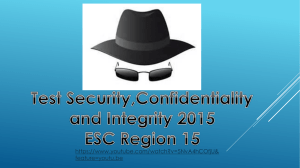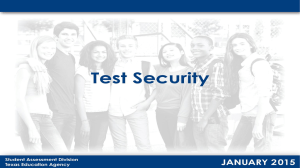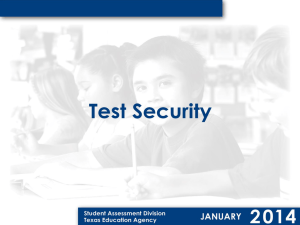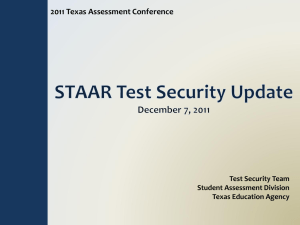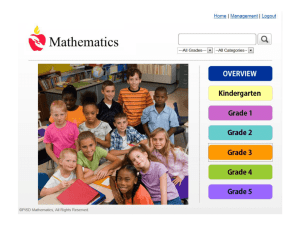TESTSECURITY2014
advertisement
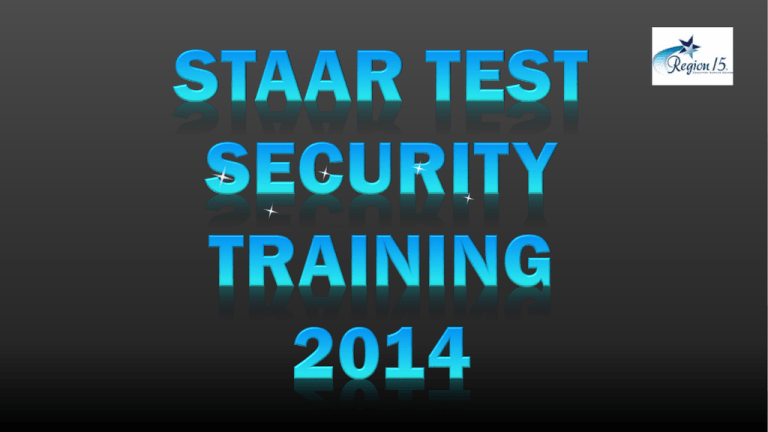
TEST SECURITY TRAINING 2014 Section 1: PURPOSE OF THE SUPPLEMENT Maintaining the security and confidentiality of the Texas student assessment program is critical for ensuring valid test scores and providing standard and equal testing opportunities for all students. Given the high stakes associated with student performance and the multifaceted nature of the assessment program, test administration personnel face challenges in managing the program’s requirements at the local level. This document is not intended to replace any procedures or instructions contained in the current District and Campus Coordinator Manual or test administrator manuals. It is provided to testing personnel as a supplement to further support incident-free test administrations. Section 2: PENALTIES FOR VIOLATIONS OF SECURITY & CONFIDENTIALITY OF ASSESSMENTS Violation of security or confidentiality of any test required by the Texas Education Code (TEC), Chapter 39, Subchapter B, shall be prohibited. A person who engages in conduct prohibited by the Test Security Supplement may be subject to sanction of credentials. Charter school test administrators are not required to be certified; however, any irregularity in the administration of any test required by the TEC, Chapter 39, Subchapter B, would cause the charter itself to come under review by the commissioner of education for possible sanctions or revocation, as provided under the TEC, §12.115(a)(4). Section 2: PENALTIES FOR VIOLATIONS OF SECURITY & CONFIDENTIALITY OF ASSESSMENTS Procedures for maintaining the security and confidentiality of state assessments are specified in the Test Security Supplement and in the appropriate test administration materials. Conduct that violates the security and confidentiality of a test is defined as any departure from the test administration procedures established in this supplement and other test administration materials. Conduct of this nature may include, but is not limited to, the following acts and omissions: Section 2: PENALTIES FOR VIOLATIONS OF SECURITY & CONFIDENTIALITY OF ASSESSMENTS changing or altering a response or answer of an examinee to a secure test item; aiding or assisting an examinee with a response or answer to a secure test item; providing, suggesting, or indicating to an examinee a response or answer to a secure test item; duplicating secure examination materials; disclosing the contents of any portion of a secure test; viewing a test before, during, or after an assessment unless specifically authorized to do so; failing to report to an appropriate authority that an individual has engaged in conduct outlined in the items listed above fraudulently exempting or preventing a student from the administration of a required state assessment; or encouraging or assisting an individual to engage in the conduct described in the items listed above. Section 2: PENALTIES FOR VIOLATIONS OF SECURITY & CONFIDENTIALITY OF ASSESSMENTS • Any person who violates, assists in the violation of, or solicits another to violate or assist in the violation of test security or confidentiality, as well as any person who fails to report such a violation is subject to the following penalties: placement of restrictions on the issuance, renewal, or holding of a Texas educator certificate, either indefinitely or for a set term; issuance of an inscribed or non-inscribed reprimand; suspension of a Texas educator certificate for a set term; or revocation or cancellation of a Texas educator certificate without opportunity for reapplication either for a set term or permanently. Section 2: PENALTIES FOR VIOLATIONS OF SECURITY & CONFIDENTIALITY OF ASSESSMENTS • Release or disclosure of confidential test content is a Class C misdemeanor and could result in criminal prosecution under TEC §39.0303, Section 552.352 of the Texas Government Code, and Section 37.10 of the Texas Penal Code. Further, 19 TAC §249.15 stipulates that the State Board for Educator Certification may take any of the above actions based on satisfactory evidence that an educator has failed to cooperate with TEA in an investigation. • In addition, any irregularities in test security or confidentiality may result in the invalidation of students’ assessments. Section 2: PENALTIES FOR VIOLATIONS OF SECURITY & CONFIDENTIALITY OF ASSESSMENTS The superintendent and campus principal of each school district and chief administrative officer of each charter school and any private school administering the tests as allowed under TEC §39.033, must develop procedures to ensure the security and confidentiality of the tests specified in the TEC, Chapter 39, Subchapter B. These administrators will be responsible for notifying TEA in writing of conduct that violates the security or confidentiality of a test administered under the TEC, Chapter 39, Subchapter B. Failure to report can subject the person responsible to the applicable penalties. Principals and campus test coordinators are responsible for security and confidentiality of test materials on their campus. Section 3: POLICY AND PROCEDURE HIGHLIGHTS TRAINING REQUIREMENTS: All district and campus personnel who participate in state-mandated testing or handle secure test materials must meet the eligibility requirements detailed in this supplement and the appropriate test administration materials, be trained, and sign a security oath. Testing personnel are required to receive annual training in test security and administration procedures and are responsible for complying with state assessment requirements. By signing the Oath of Test Security and Confidentiality, participants affirm that they have been trained, understand their obligation to properly implement the program, acknowledge their responsibility to report any suspected testing irregularity to the campus or district testing coordinator, principal, or TEA, and are aware of the range of penalties that may result from a violation of test security and confidentiality. Section 3: POLICY AND PROCEDURE HIGHLIGHTS TRAINING REQUIREMENTS (continued): Districts allowing certified or noncertified paraprofessionals (e.g., teacher aides) to access secure materials or to administer tests must identify a certified staff member who will be responsible for supervising these individuals. If a violation of test security or confidentiality occurs under these circumstances, the supervising certified professional is subject to the penalties above. Section 3: POLICY AND PROCEDURE HIGHLIGHTS SECURE STORAGE AREAS Finding a suitable location to store secure assessment materials can present certain logistical issues; however, it is required that these items be kept in a secure locked storage area when not in use. Districts and campuses must ensure that access to secure storage is limited to one person or very few individuals and that these individuals are the only people who possess keys to the locked storage area. District coordinators are encouraged to affirm that all campuses are following these storage requirements. Section 3: POLICY AND PROCEDURE HIGHLIGHTS STAAR TEST SESSION TIME LIMITS: Beginning in 2014, the STAAR and STAAR Modified English I and English II assessments will have a five-hour time limit. All other assessments (STAAR, STAAR Spanish, STAAR L, STAAR Modified) will have a fourhour time limit. Students must complete the test within the same school day. Campuses should use a clock or a timer to monitor test time. The time period starts after the test administrator has read and answered any questions regarding the test directions and tells students to begin working on their tests. Once the test has begun, the test administrator must communicate (orally or in writing) the amount of time left to test in one-hour intervals and, if desired, in shorter intervals during the last hour. Students who do not complete their tests within the time limit must submit what they have completed. Students will be informed in the test administrator directions that materials will be collected at the end of the time period and that they must record all responses before this period ends. Students will not be allowed to record responses onto their answer documents or into TestNav after the time period has ended. Section 3: POLICY AND PROCEDURE HIGHLIGHTS TEST ADMINISTRATION WINDOWS, FLEXIBLE SCHEDULING, AND MAKE-UP TESTING : • In an effort to accommodate local needs, districts have been provided the latitude to adjust test dates for certain STAAR assessments as necessary within the scheduled administration windows. This flexibility applies to all STAAR grades 3-8 and end-of-course (EOC) assessments with the exception of the STAAR and STAAR Modified grades 4 and 7 writing and English I and English II assessments. • The STAAR program allows districts to offer make-up testing opportunities for all grades and subjects to students who are absent on regularly scheduled assessment days. Make-up testing is optional, at the discretion of the district, and must be completed by the end of the testing window as specified on the Calendar of Events. Section 3: POLICY AND PROCEDURE HIGHLIGHTS REFERENCE MATERIALS, SCRATCH PAPER, GRAPH PAPER, AND CHARTS: • Reference materials (e.g., formula charts) for STAAR mathematics and science assessments and graph paper for STAAR mathematics assessments will be included in the test booklets issued to students. These materials will be printed on perforated pages so that students can remove them for use during the test administration. Scratch paper may also be provided. Districts must ensure that any reference materials and graph paper that have been written upon AND removed from the test booklet and any scratch paper used and written upon are destroyed immediately after the test session is complete. All charts written on by students during TAKS administrations must be collected and destroyed after testing. • All personnel who handle these materials should be aware that they may contain secure test content and that any viewing or recording of this confidential information is strictly prohibited. Section 3: POLICY AND PROCEDURE HIGHLIGHTS STUDENT CHEATING ON STATE ASSESSMENTS: • The monitoring procedures outlined in this supplement, the current District and Campus Coordinator Manual, and the corresponding test administrator manuals require districts and campuses to implement any necessary measures to prevent cheating. If a district determines that a student has been involved in an attempt to cheat on a state assessment – either by providing or receiving assistance – the district is required to invalidate the student’s test by marking the score code “O” for “Other” on the student answer document for the corresponding test. The test invalidation and any additional disciplinary actions taken by the district must be reported to TEA via the online Locally Determined Disciplinary Action (LDDA) form that can be found on the Test Security page of the TEA website at: http://www.tea.state.tx.us/student.assessment/security • Submission of a separate online incident report form will be necessary ONLY IF the district determines that adult testing personnel contributed to, caused, or did not detect the cheating due to inadequate monitoring. Section 3: POLICY AND PROCEDURE HIGHLIGHTS INVESTIGATING AND REPORTING TESTING IRREGULARITIES: • Incidents resulting in a deviation from documented testing procedures are defined as testing irregularities. They are viewed by TEA as falling into one of two categories – serious and procedural. • Serious irregularities constitute severe violations of test security or confidentiality and can result in the individual(s) responsible being referred to the TEA Educator Standards and Certification Legal Division for consideration of disciplinary action (including suspension or revocation of educator certification credentials). • Procedural irregularities are less severe, more common, and are typically the result of minor deviations from testing procedures. Section 3: POLICY AND PROCEDURE HIGHLIGHTS INVESTIGATING AND REPORTING TESTING IRREGULARITIES Each person participating in the Texas student assessment program is responsible for reporting any violation or suspected violation of test security or confidentiality. Campus staff should notify their campus or district testing coordinator if they witness an irregularity or suspect that one has occurred, and district testing coordinators should in turn notify TEA. The district testing coordinator must contact the TEA Student Assessment Division immediately to report incidents involving alleged or suspected violations that fall under the category of a serious irregularity as soon as the district testing coordinator is made aware of the situation. Testing personnel should contact TEA if they are unsure about whether an irregularity has occurred or if they are unclear regarding what constitutes a serious violation. Section 3: POLICY AND PROCEDURE HIGHLIGHTS INVESTIGATING AND REPORTING TESTING IRREGULARITIES : Reporting requirements differ based on the severity of the confirmed or alleged violation(s). District coordinators must determine whether the incident is a serious or procedural irregularity and report the incident using the Online Incident Report form. The contents of the report submitted to TEA must clearly lay out the sequence of events of the testing irregularity and include the district’s determination on the matter. Beginning in 2014, district officials must additionally complete the Plan of Action section in the Online Incident Report and specify the steps they will take to prevent a reoccurrence of the irregularity. Information provided in district reports, particularly in the Plan of Action, will be used by TEA in an audit of selected districts to verify that they have implemented corrective actions in response to reported irregularities. Section 3: POLICY AND PROCEDURE HIGHLIGHTS INVESTIGATING AND REPORTING TESTING IRREGULARITIES : The nature of serious allegations requires an immediate investigation by the district in order to gather all necessary evidence while the involved individuals are still available and able to recall details. Therefore, districts must respond to the report of an irregularity and submit the required information for serious irregularities within ten working days of becoming aware of the violation. If the district fails to comply with or does not respond to requests for information, TEA will contact the district coordinator to provide support or will contact the superintendent to seek assistance. More information about the specific reporting requirements associated with serious and procedural irregularities can be found in the Incident Reporting section of this supplement. Section 4: MAKING YOUR PROGRAM SECURE PLANNING FOR POSSIBLE TESTING DISRUPTIONS: Disruptions in testing generally involve unplanned situations that can usually be resolved when properly handled. Having a plan in place to address unforeseen events can contribute to a successful resolution and can help to ensure that there is minimal impact on students. District testing coordinators should contact the Student Assessment Division as soon as possible to seek guidance in handling any significant disruptions. To prepare for any unexpected disruptions, the district should consider the following: • Ensure that all campuses are aware of what to do and who to contact if a disruption takes place during testing. • Make certain that each campus has a plan in place for securing test materials and maintaining confidentiality in the event of a disruption during testing. (Remember that the safety of students and staff is the first consideration in the event of a serious disruption during testing.) Section 4: MAKING YOUR PROGRAM SECURE TRAINING: Assessment staff should not write or place labels on areas of the test booklet or answer document that are reserved for student use. Staff may write or place labels in the upper right portion on the front cover of students’ test booklets as long as these actions do not result in test administrators deviating from scripted directions. If space permits, staff may also write test booklet numbers in the upper right portion on the front of students’ answer documents. No other label besides the precoded label should ever be placed on an answer document. Section 4: MAKING YOUR PROGRAM SECURE MONITORING AND OVERSIGHT: During testing, district coordinators should be available to answer questions and resolve issues. Monitoring campuses during an administration can help confirm that procedures are being followed and can minimize the risk of error. Principals and campus testing coordinators play a critical role in this effort, ensuring that each test administrator is actively monitoring and that all testing personnel are adhering to the proper assessment procedures. • Test administration personnel must check to see if test administrators have all necessary materials (e.g., test administrator manuals, test booklets, and answer documents). • Campus principals and coordinators must verify that test administrators are actively monitoring students. • Testing personnel should verify that all testing areas are free from instructional displays. (In situations where the campus must relocate examinees, the area to which the students will be moved should also be checked.) Section 4: MAKING YOUR PROGRAM SECURE MONITORING AND OVERSIGHT: • Campus personnel should be available to monitor students properly during breaks. • Campus principals and coordinators must verify that test administrators are properly completing a seating chart for each test session. Make sure seating charts include any students who moved, transferred, or arrived late to a test session. • Test administrators must monitor the testing time and be announcing the time-left-to-test in one hour intervals (more during the last hour if desired). • For breaks that require the time clock to be stopped, ensure that test administrators are recording the stop and restart times on the seating chart. • Testing personnel must ensure that students are being administered the appropriate tests and have been issued the correct corresponding answer documents. • All test administrators are required to ensure that students have marked their responses on their answer documents before the end of the four-hour time period. • The campus principal and test coordinator (or their designees) must be available to support test administrators as needed. Section 5: TESTING IRREGULARITIES SERIOUS VIOLATION EXAMPLES: • • • • • • • • Directly OR indirectly assisting students with responses to test questions Tampering with student responses Falsifying TELPAS holistic ratings or STAAR Alternate student performance data Viewing secure test content before, during, or after an administration or viewing STAAR Alternate performance data during or after an assessment (unless specifically authorized to do so by the procedures outlined in the test administration materials) Discussing secure test content, student responses, or student performance Duplicating, recording, or capturing electronically secure test content without permission from TEA Scoring student tests, either formally or informally Fraudulently exempting or preventing a student from the administration of a required state assessment Section 5: TESTING IRREGULARITIES Any incidents involving alleged or suspected violations that fall under the category of a serious irregularity must be reported to the TEA Student Assessment Division as soon as the district coordinator is made aware of the situation. Testing personnel should contact TEA if they are unsure whether an irregularity has occurred or if they are unclear regarding what constitutes a serious violation. Section 5: TESTING IRREGULARITIES PROCEDURAL VIOLATIONS: ELIGIBILITY ERROR EXAMPLES • An English language learner (ELL) whose parents had waived district ESL services was not administered the TELPAS assessment. • A student was administered a STAAR assessment when he or she should have taken STAAR Modified. Many eligibility errors, when identified in a timely manner, can be resolved with minimal impact to students. Testing personnel should be instructed to immediately notify their campus or district coordinator if they suspect a student is being or has been tested incorrectly. Contact TEA if guidance is needed. Section 5: TESTING IRREGULARITIES PROCEDURAL VIOLATIONS: MONITORING ERROR EXAMPLES: • A test administrator left a room unmonitored when students or secure materials were present or when secure online assessments were open and visible. • A test administrator left secure materials unattended or secure online assessments open and visible during a lunch break. • A test administrator did not verify that a student recorded his or her responses and accepted a blank answer document from the examinee. • Students who had not finished testing were not properly monitored during a break. • A test administrator did not actively monitor students and did not detect the improper use of a dictionary or calculator. • A test administrator did not ensure that students worked independently during testing. • Students were not prevented from using cell phones or any other electronic device to take pictures or send messages. Section 5: TESTING IRREGULARITIES PROCEDURAL VIOLATIONS: MONITORING ERROR EXAMPLES: Students are NOT permitted to have cell phones or personal electronic devices that allow Internet access or have photographic capabilities during testing as the devices can disrupt the testing environment and be used to compromise the security and confidentiality of the test. These devices cannot be used to fulfill the requirements of the STAAR Dictionary Policy or the STAAR Calculator Policy. Districts are required to have procedures in place to prevent the use of these devices during test administrations. Section 5: TESTING IRREGULARITIES PROCEDURAL VIOLATIONS: MONITORING ERROR EXAMPLES: • Monitoring-related errors are some of the most common types of incidents. Regardless of whether these mistakes directly or indirectly contribute to testing irregularities, they are one of the more problematic assessment issues that districts must address. Such errors can also be detrimental to students. Accepting a blank answer document, for example, will result in a student not receiving credit for a test that he or she took. Other monitoring-related errors might lead to breaches in confidentiality that could place students’ test scores in question. • For ALL incidents where examinees were left unmonitored or had access to nonallowable manipulatives, instructional aids, or unattended secure materials, districts are required to provide a determination on the online incident form of whether confidentiality was breached or if the irregularity compromised the validity of a student’s assessment. Section 5: TESTING IRREGULARITIES OTHER PROCEDURAL ERROR EXAMPLES: • An unauthorized individual (e.g., a student or untrained personnel) was permitted to transport secure test material. • A test administrator did not issue the correct materials (i.e., #2 pencils, dictionaries, calculators) or students were incorrectly permitted to use nonallowable materials. • Testing personnel did not use the test administrator manual or failed to read the test administration script verbatim as outlined in the manual. • A student was permitted to test beyond the allowed time limit on a STAAR assessment or was not provided the full time allotment to complete an assessment. • Personnel were permitted to administer tests, monitor test sessions, or handle secure materials even though they had not been properly trained or did not sign the appropriate oath(s). • A TELPAS writing collection was not submitted in accordance with required assembly criteria. • A test administrator failed to remove or cover all instructional displays. INCIDENT REPORTING • Despite how well prepared testing personnel may be, the possibility still exists that a mistake will be made. When incidents occur, it is important to have procedures in place to help ensure that all the necessary information is gathered so the district can make a clear determination about what occurred. • All confirmed testing irregularities must be reported to the TEA Student Assessment Division via the online incident report form. District coordinators must immediately notify TEA as soon as they are made aware of any alleged or suspected violations that fall under the category of a serious irregularity. The nature of serious allegations requires an immediate investigation by the district in order to gather all necessary information while the involved individuals are still available and able to recall details. Districts must ensure that all testing personnel are aware of their obligation to report testing irregularities and can easily access local reporting procedures. Section 6: INCIDENT REPORTING IMPORTANT NOTE Regarding the District’s Obligation to Investigate and Report Testing Violations : • The superintendent in each school district, the chief administrative officer of each charter school, and any private school administering tests as allowed under TEC, §39.033, must ensure that TEA is notified of any conduct that violates the security or confidential integrity of a test. • Failure to cooperate with TEA in an investigation or to properly report that an individual has engaged in conduct that violates the security and/or confidentiality of a test is itself a violation of 19 TAC §249.15(b)(6) and (b)(8) and could result in sanctions. Section 6: INCIDENT REPORTING REPORTING REQUIREMENTS FOR SERIOUS IRREGULARITIES : • The district testing coordinator (or his or her designee) is responsible for investigating confirmed or alleged serious testing violations and must notify the TEA Student Assessment Division as soon as the district is made aware of the situation. Depending on the nature and severity of the issue, TEA may request that the district take certain actions, such as interviewing students or interpreting test results, to ensure a thorough and complete investigation. At a minimum, each of the following items must be completed and submitted by the district to fulfill the state’s requirements for reporting serious testing violations: • • • • • an Online Incident Report typed, dated, and signed statement(s) from the individual(s) involved the district’s determination of exactly what happened and why the incident occurred a description of how the incident was resolved the Plan of Action section of the Online Incident Report (describes the steps that a district will take to ensure that the irregularity does not reoccur) Section 6: INCIDENT REPORTING REPORTING REQUIREMENTS FOR PROCEDURAL IRREGULARITIES : Because procedural irregularities are often the result of minor errors that do not generally represent severe breaches in test security or confidentiality, they require only the submission of an Online Incident Report. New in 2014, districts must complete the Plan of Action as part of the incident report, describing the district’s plan to prevent the reoccurrence of the incident. For these types of irregularities, the district’s reporting obligation is fulfilled once the online submission has been completed. If more information is needed, TEA will notify the district coordinator. Reports for procedural errors must be submitted within ten working days of the district coordinator being made aware of the incident. If more time is needed, coordinators can contact the Student Assessment Division’s security team by phone at 512-463-9536 or via email at testsecurity@tea.state.tx.us For procedural irregularities, follow the instructions on the online incident report form. You will need to: • • • • • • clearly outline the sequence of events; explain what happened and how it occurred; include information about how the problem was resolved or remedied; include the name of the individual who assisted you if TEA was contacted; include a district determination in the matter; and provide a plan of action that the district will put into effect to ensure that the incident does not reoccur. Section 6: INCIDENT REPORTING Please DON’T ASSUME!!! • Student Assessment staff are experienced in assisting districts with handling and reporting testing irregularities and are available to provide guidance for district personnel. Do not hesitate to contact staff at 512-463-9536 if you have questions about an incident that occurred in your district, its severity, or the correct way to report it. • Additional resources, including information regarding how to conduct thorough investigations, can be found on the Student Assessment Division’s test security webpage located at: http://www.tea.state.tx.us/student.assessment/security/ OPTIONAL WEB-BASED TEST ADMINISTRATOR TRAINING MODULES Updated Test Administrator Training Modules are now available for your use at http://www.texasassessment.com/securitytraining Content has been revised to reflect the State of Texas Assessments of Academic Readiness (STAAR) program and additional online testing scenarios have been included. Completion of these modules is not a requirement. It is, however, recommended that districts and charter schools use these modules to help supplement the mandatory training required of all personnel involved in testing. OPTIONAL WEB-BASED TEST ADMINISTRATOR TRAINING MODULES The modules address the following topics: • Active Monitoring: Module 1 explains the expectations for active monitoring and demonstrates how to correctly implement this requirement. • Distribution of Test Materials: Module 2 familiarizes personnel with common errors made when materials are distributed and offers strategies for preventing these mistakes. • Proper Handling of Secure Materials: Module 3 addresses the expectations for protecting the contents of secure test materials and presents examples of the risks and consequences of common errors that could result in breaches of security and confidentiality. CONTACT INFORMATION PLEASE CONTACT ME IF YOU HAVE ANY QUESTIONS: KIM NIEHUES kim.niehues@esc15.net (325) 481-4047
